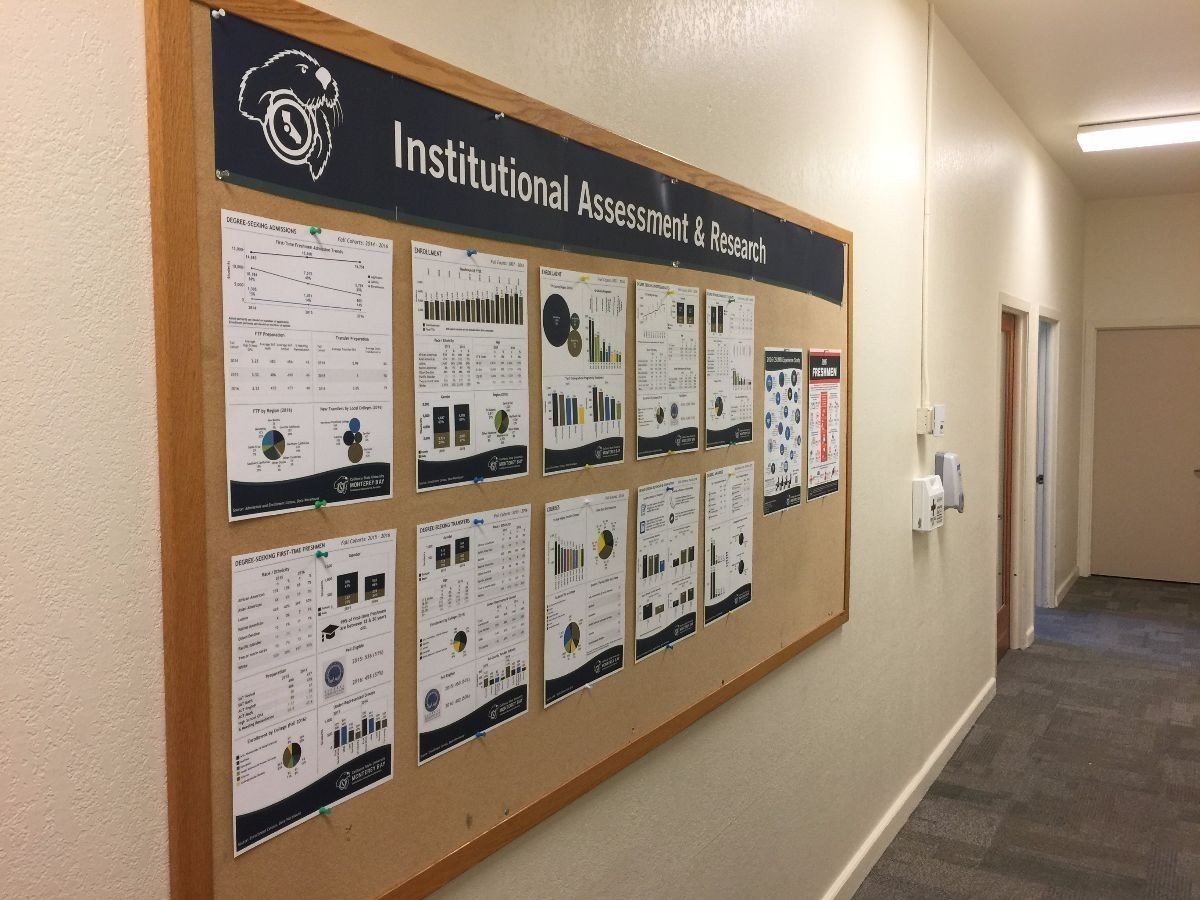IAR Insights - Fall 2017

In this issue:
CSUMB as a Hispanic-Serving Institution: By the Numbers
- What is a Hispanic-Serving Institution?
- Why the HSI designation?
- When did CSUMB officially become a HSI?
- What are the historical growth trends of CSUMB’s Hispanic student enrollment?
- When did Hispanic students become CSUMB’s largest race / ethnicity group?
- What are CSUMB's top undergraduate programs in terms of Hispanic student enrollment?
- What are CSUMB's retention trends for Hispanic students?
- What are CSUMB's graduation trends for Hispanic students?
What is a Hispanic-Serving Institution (HSI)?
The U.S. Department of Education designates eligible higher education institutions as “Hispanic-serving” if they have enrollments of undergraduate Hispanic full-time equivalent (FTE) students that total at least 25% of the institution’s total undergraduate FTE enrollment at the end of the award year for which the institution applies for the designation.
Why the HSI designation?
In 1992, under Title V of the Higher Education Act, the U.S. Congress began to formally designate higher education institutions as Hispanic-serving to expand education opportunities and academic attainment for Hispanic students. The purpose of this designation is to enhance the academic offerings, program quality, and institutional stability of colleges and universities that are educating the majority of Hispanic college students so these educational institutions can help large numbers of Hispanic students and other low-income individuals complete postsecondary degrees (see Title 20 Chapter 28 Subchapter V Part A of the U.S. Code for additional information).
When did CSUMB officially become an HSI?
CSUMB first became eligible for the HSI designation in Spring 1998, just a few years after the founding of the university.
What are the historical growth trends of CSUMB’s Hispanic student enrollment?
CSUMB’s Hispanic Undergraduate FTE Enrollments have grown significantly between Fall 2008 and Fall 2017, increasing from 1,078 to 2,693, an increase of 150%. This is also true of the percentage of the undergraduate FTEs that are Hispanic students, growing from 28% in Fall 2008 to 43% in Fall 2017, with the only exception being Fall 2009 when the percentage dropped by 1%.
In comparison, CSUMB’s Overall Undergraduate FTE Enrollments have also been growing, increasing from 3,800 in Fall 2008 to 6,311 in Fall 2017, an increase of 66%. (Each year enrollment experienced growth except for Fall 2017, when CSUMB decreased by 153 undergraduate FTE enrollments compared to Fall 2016.) There was a notable jump in overall enrollment between Fall 2013 at 5,167 to Fall 2014 at 6,028.
Term Undergraduate Hispanic FTE Enrollment (Count) Undergraduate Hispanic FTE Enrollment (Percent) Overall Undergraduate FTE Enrollment (Count) Fall 2008 1,078 28% 3,800 Fall 2009 1,131 27% 4,223 Fall 2010 1,338 30% 4,472 Fall 2011 1,601 33% 4,876 Fall 2012 1,714 34% 5,082 Fall 2013 1,784 35% 5,167 Fall 2014 2,134 35% 6,028 Fall 2015 2,398 38% 6,374 Fall 2016 2,617 40% 6,464 Fall 2017 2,693 43% 6,311 Data is from the CSUMB Data Warehouse and includes State Support only.
When did Hispanic students become CSUMB’s largest race / ethnicity group?
Hispanic students surpassed White students as the largest race / ethnicity group at CSUMB, beginning in Fall 2015, with Hispanics comprising 38% of the university’s undergraduate FTE enrollment. As of Fall 2017, Hispanic students now make up 43% of the total undergraduate FTE enrollment.
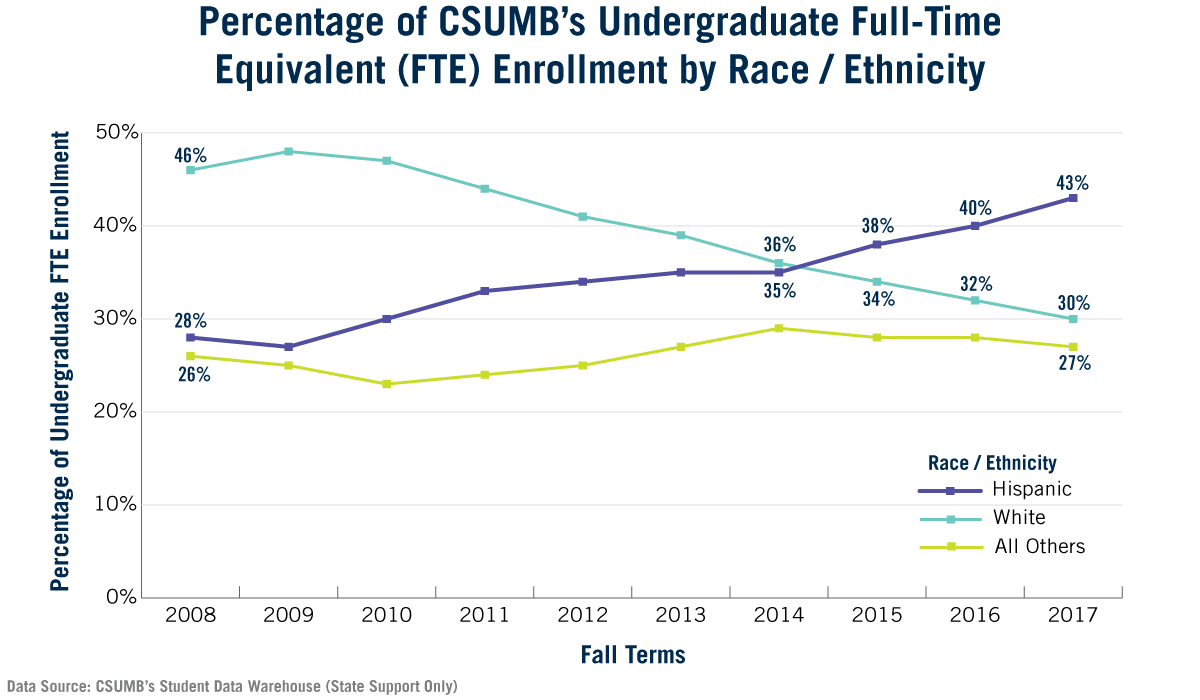
Through Fall 2014, White students made up the largest race / ethnicity group of CSUMB’s undergraduate FTE student body. Declines in the White percentage and growth in the Hispanic percentage of CSUMB’s enrollments began in Fall 2010 and have continued through Fall 2017.
Hispanic students surpassed White students as the largest race / ethnicity group at CSUMB, beginning in Fall 2015, with Hispanics comprising 38% of the university’s undergraduate FTE enrollment. As of Fall 2017, Hispanic students now make up 43% of the total undergraduate FTE enrollment, with White students making up only 30% and All Others 27%. Note that All Others FTE enrollment has essentially remained flat growing only 1% between 2008 and 2017.
Data is from the CSUMB Data Warehouse and includes State Support only.
What are CSUMB's top undergraduate programs in terms of Hispanic student enrollment?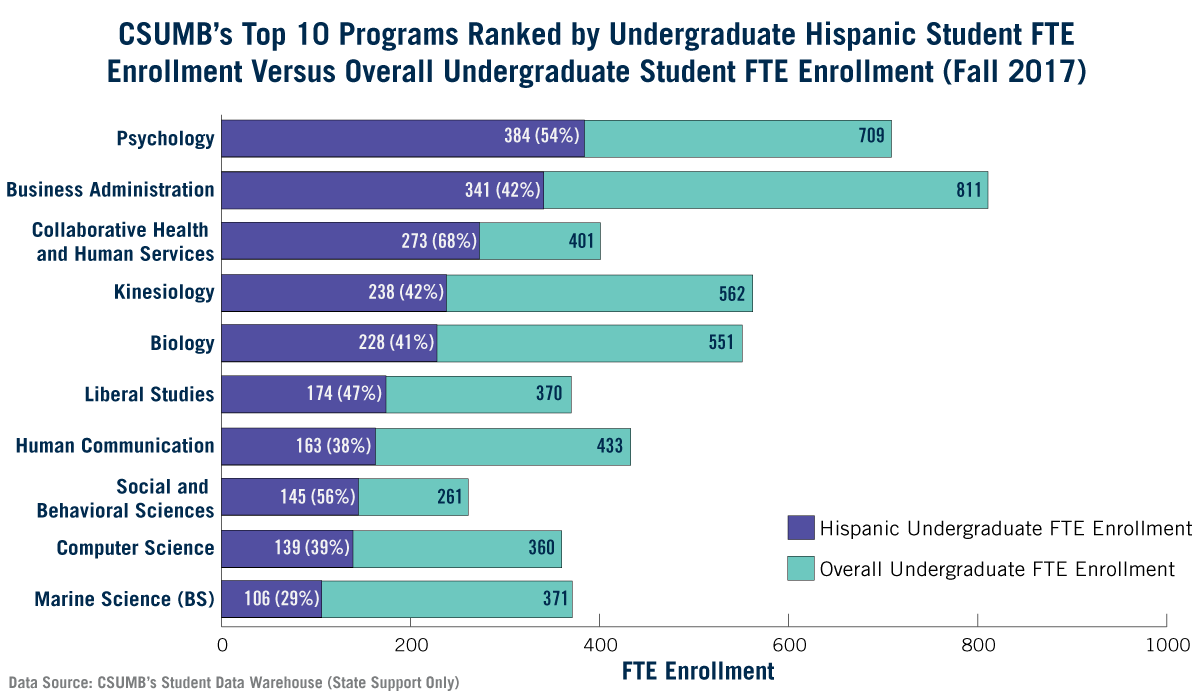
For Fall 2017, the largest undergraduate programs by Hispanic student enrollment were Psychology (384), Business Administration (341), Collaborative Health and Human Services (273), Kinesiology (238), and Biology (228). Smaller programs that round out the top 10 programs include Liberal Studies (174), Human Communications (163), Social and Behavioral Sciences (145), Computer Science (139), and Marine Science (106).
The programs in the chart are listed from the greatest number of Hispanic Undergraduate FTE students enrolled to the lowest number of Hispanic Undergraduate FTE students enrolled Fall 2017. Beside the Hispanic Undergraduate FTE Enrollment counts in the chart, the percent of the overall program enrollment FTEs that are Hispanic students are provided. The percentage of Hispanic enrollment by program are as follows: Collaborative Health and Human Services (68%), Social and Behavioral Sciences (56%), Psychology (54%), Liberal Studies (47%), Business Administration (42%), Kinesiology (42%), Biology (41%), Computer Science (39%), Human Communications (38%), and Marine Science (BS) (29%).
Also provided for comparison are Overall Undergraduate FTE enrollment to provide perspective on the size of each program. Overall Undergraduate FTEs includes all undergraduate FTE enrollments, including the Hispanic Undergraduate FTE enrollments. Overall Undergraduate FTEs for the programs listed include Psychology (709), Business Administration (811), Collaborative Health and Human Services (401), Kinesiology (562), Biology (551), Liberal Studies (370), Human Communications (433), Social and Behavioral Sciences (261), Computer Science (360), and Marine Science (BS) (371).
Data is from the CSUMB Data Warehouse and includes State Support only.
What are CSUMB's retention trends for Hispanic students?
The retention rates of CSUMB’s Hispanic students between the Fall 2008 entering cohort and the Fall 2016 entering cohort have been increasing at rates similar to increases in retention rates for CSUMB students overall.
For Hispanic first-time freshmen (FTF), the retention rates have been 1-2 percentage points higher than for all FTF, increasing from 72% for the Fall 2008 entering cohort to 82% for the Fall 2016 entering cohort. CSUMB’s overall FTF 1-year retention rates have also risen gradually from the Fall 2008 entering cohort (71%) to the Fall 2016 entering cohort (80%).
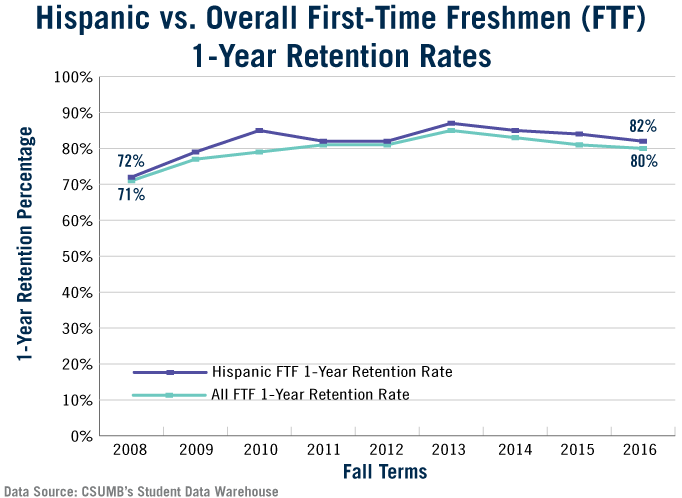
The Hispanic upper division transfer (UDT) 1-year retention rate has also increased reaching 74% for the Fall 2008 entering cohort and 88% for the Fall 2016 entering cohort. The 1-year retention rate for all CSUMB’s UDTs has also risen gradually from 75% for the Fall 2008 entering cohort to 87% for the Fall 2016 entering cohort.
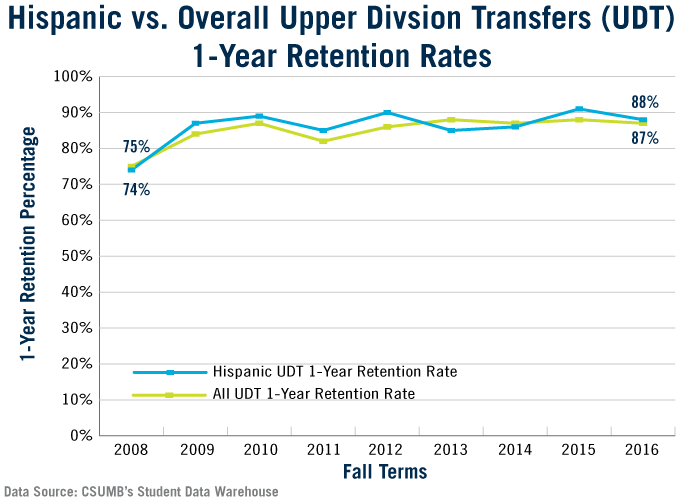
First-Time Freshmen (FTF)
The retention rates of all CSUMB’s FTF have been increasing over the 2008-2016 time period, growing from 71% Fall 2008 to 80% Fall 2016. Hispanic student have fared equally as well, improving their 1-year retention rate from 72% to 82%. It is notable that Hispanic students are performing above the overall rate of performance of the University by a small margin of 1-2%. Fall 2010 and Fall 2013 were high points for Hispanic FTF 1-Year retention results with the retention rate reaching or exceeding 85%.
Upper Division Transfers (UDT)
The Hispanic upper division transfer 1-year retention rate has increased reaching 74% for the Fall 2008 entering cohort and 88% for the Fall 2016 entering cohort. The 1-year retention rate for all CSUMB’s upper division transfers has also risen gradually from 75% for the Fall 2008 entering cohort to 87% for the Fall 2016 entering cohort. During the Fall 2013 and Fall 2014 Hispanic student upper division transfer 1-year retention rates did fall below that of All Upper Division transfers by a small margin.
What are CSUMB's graduation trends for Hispanic students?
The Hispanic FTF graduation rates as of the Fall 2013 entering cohort are slightly lower (26%) than the overall FTF rate (30%) for 4-year graduation. However, the 6-year graduation rate for the Fall 2011 entering cohort is comparable between Hispanic FTF and overall FTF (59% for both groups). Graduation rates for all FTF have increased from Fall 2008 through the present.
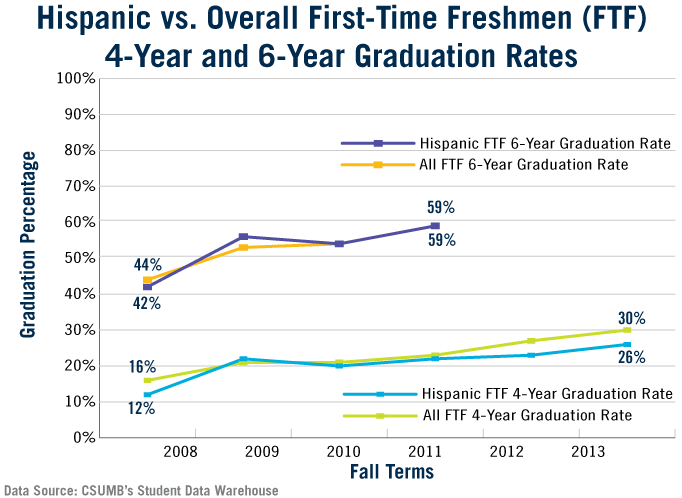
Both All Upper Division Transfer and Hispanic Upper Division Transfer 2-year and 4-year graduation rates have also increased between the Fall 2008 and Fall 2015 entering cohorts (most recent data). The 2-year graduation rate for Hispanic UDTs was 41% for the Fall 2015 entering cohort compared to 42% for UDTs overall. The 4-year graduation rate for Hispanic UDTs was 73% for the Fall 2013 entering cohort compared to 77% for UDTs overall.
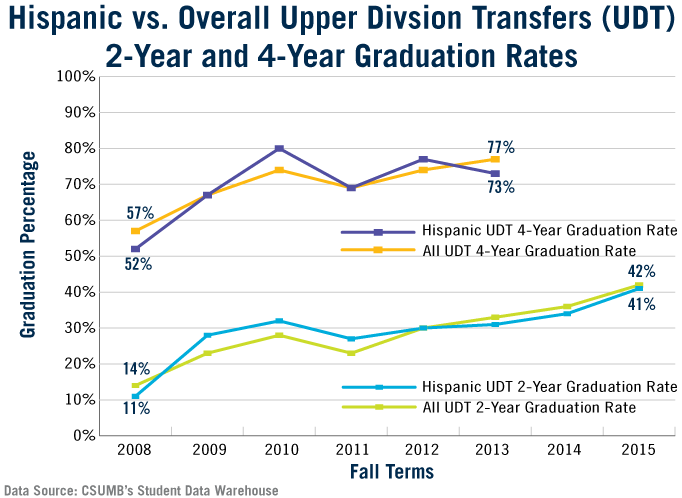
First-Time Freshmen (FTF)
The Hispanic FTF graduation rates as of the Fall 2013 entering cohort are slightly lower (26%) than the overall FTF rate (30%) for 4-year graduation. Hispanic FTF 4-year graduation rates did surpass All FTF with the Fall 2009 entering cohort by a small percentage, otherwise it has lagged by a few percentage points.
The 6-year graduation rate for first-time freshman, however, does not show this pattern, with Hispanic students matching or outperforming All FTF starting in Fall 2009. The Fall 2011 entering cohort (Fall 2011 most recent data) is comparable between Hispanic FTF and overall FTF (59% for both groups). Graduation rates for all FTF have increased from the Fall 2008 through the present.
Upper Division Transfer (UDT)
Both All Upper Division Transfer and Hispanic Upper Division Transfer 2-year and 4-year graduation rates have increased between the Fall 2008 and Fall 2015 entering cohorts (Fall 2015 is most recent data). The 2-year graduation rates for all upper division transfers have climbed from 14% to 42% between Fall 2008 and Fall 2015, a 28% increase. In comparison, the Hispanic 2-year graduation rate has climbed from 11% in Fall 2008 to 41% in Fall 2015, a 30% increase.
The 4-year graduation rate for All Upper Division Transfer and Hispanic Upper Division Transfer has shown greater variability. Hispanic results show an overall gain from 52% Fall 2008 to 73% Fall 2015, a 21% increase. The highest result for Hispanic upper division transfer graduation success was 80% in Fall 2010, 7% higher than Fall 2015 results. All upper division transfers show a gain from 57% Fall 2008 to 77% Fall 2015, a 20% increase. All upper division transfers also show variability but the current Fall 2015 4-year graduation rate of 77% is the highest achieved during the reporting period.
IAR is located in Green Hall (Building 58)
